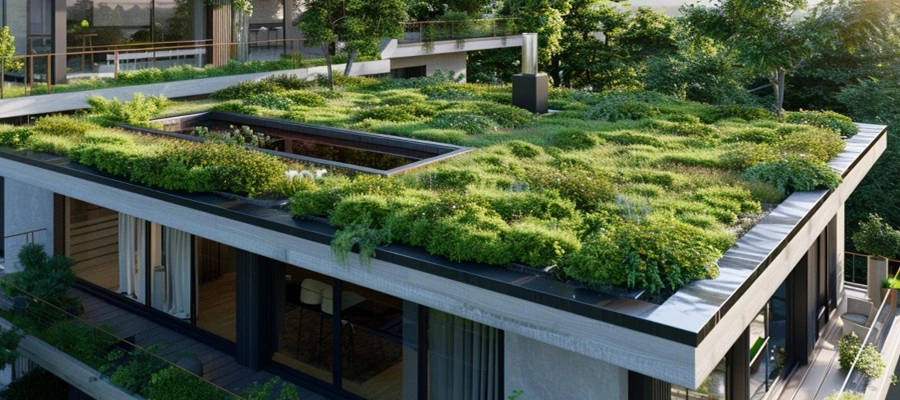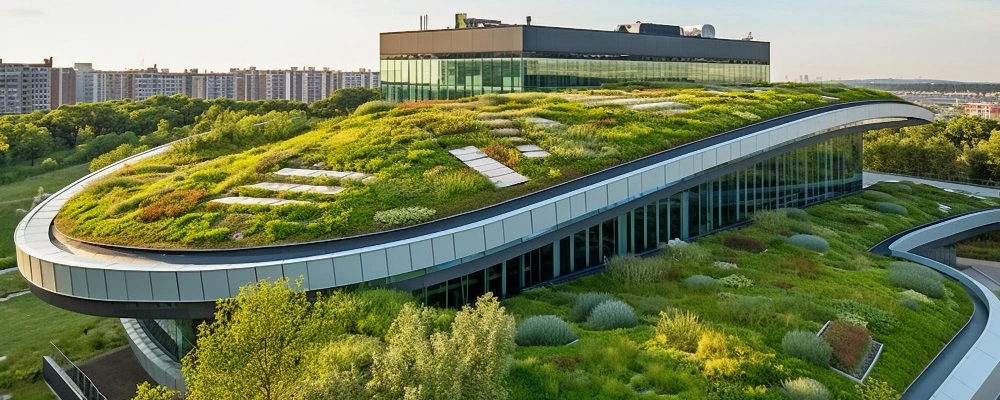In today’s world, more and more homeowners are accepting their environmental responsibility. People are actively looking for sustainable solutions to reduce their carbon footprint and make their homes more environmentally friendly. Choosing eco-roofing materials can significantly improve your home’s sustainability. In addition, choosing a green roofing option can positively impact the environment while also improving your home’s energy efficiency and saving you money in the long run.
So, in this blog, Brick & Bolt provides you with a detailed guide on green roofing benefits, including what a green roof is. It will help you make a well-informed choice for your home.
What is a Green Roof?
A building’s roof that has been planted entirely or partly with plants and a growth medium on a waterproofing membrane is known as a green roof. The green roof is also known as a living roof, roof garden, vegetative roof, or eco-roof. It includes the layers like irrigation systems, drainage systems and root barriers. Although this is up for discussion, container gardens on top of rooftops—where plants are kept in pots—are not usually regarded as real green roofs. Another kind of green roof that is used to remediate greywater is a rooftop pond. A green roof is made up of soil, vegetation, an irrigation system, a roof barrier, and a drainage layer.
Green roofs serve as a self-sustaining ecosystem that filters air and water, nourishes plant life with rainfall and effectively manages rainwater without the need for drainage or treatment systems.
Green Roofing Benefits

Green roofs undoubtedly increase the aesthetic appeal of any building. But, their benefits go beyond visual charm, as they also provide various environmental advantages.
The following are the eco-friendly roof advantages:
1. Enhances the Air Quality
Green roofs act as natural air purifiers, benefiting the local environment. Their vegetative aspect has the potential to significantly decrease greenhouse gas emissions and air pollution.
2. Energy-Saving Advantages of Eco-Friendly Roof
Green roofs help to lower energy consumption by reducing the dependency on constant heating and cooling systems because of their excellent insulation, Additionally, there can be potential economic advantages as it lead to reduced energy expenses throughout the year.
3. Helps in Retain Rainwater
An important concern in cities with extensive asphalt coverage is managing excessive rainwater. Interestingly, due to the existence of impermeable surfaces like pavement and rooftops, a regular city block produces five times the amount of runoff compared to a similar woodland area. This problem is becoming increasingly evident as climate changes lead to more frequent and intense storms in urban areas. However, green roofs can effectively manage stormwater runoff by absorbing heavy rains.
4. Creates Natural Habitat
Even in bustling cities, birds and insects require habitats to thrive. Green roofs can create natural habitats in spaces that would otherwise go unused. This not only increases biodiversity but also draws more wildlife to the urban areas.
5. Reduces Urban Temperatures
Urban areas normally have higher temperatures than rural areas. Urban areas tend to retain and accumulate heat more easily due to the larger amount of industrial materials present. Green roofs have the ability to reduce the intensity of heat by providing shade and lowering the overall air temperature.
6. Reduces the Noise Pollution
Urban areas can be quite noisy, but the green roof installation can provide a solution to this problem. Eco-roofs have the remarkable ability to decrease both internal and external noise pollution. Unlike traditional roofs that reflect and amplify sounds, the soil and plants on a green roof can reduce noise levels by an impressive 40 to 50 decibels.
7. Economic Advantages of Green Roof Installation
Installing a green roof can give many economic advantages. These include energy savings thanks to the natural insulation provided, lower maintenance expenses due to the longer lifespan of the roof, an increase in property value, and cost savings on stormwater management. These economic advantages of green roof installation make them a smart investment for home owners.
Conclusion
On a final note, numerous social, ecological, and economic advantages come with having a green roof. A green roof functions as a buffer for rainwater runoff, cleans the air, lowers outside temperatures, controls interior temperatures, conserves energy, and promotes biodiversity in urban areas. Furthermore, green environments tend to make individuals happy than gray ones. Hence, by installing green roofs, we can promote sustainable and environmentally friendly practices in the construction sector.

